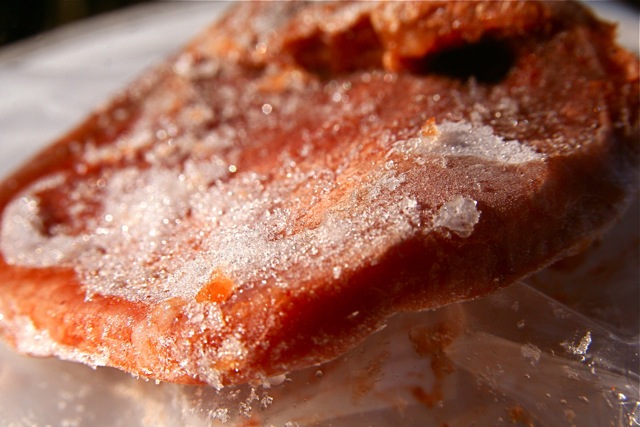Freezer Burns
 |
| Freezer Burn in steak |
 |
| Freezer Burn on Green Peas |
Understanding Freezer Burns
What are freezer burns?
- A condition when frozen food has been damaged by dehydration and oxidation
- Occurs when air reaches the food's surface and dries the product causing color change
- Freezer burn does not make the food unsafe; it merely causes dry spots in foods.
- The food remains usable and edible, and removing the freezer burns will improve the taste.
What Causes freezer burns?
- Caused by air reaching the food.
- Food is not securely wrapped in air-tight packaging.
How do you know if your frozen foods have freezer burns?
- By Color
- Freezer burn appears as grayish-brown leathery spots on frozen food
- Color changes result from chemical changes in the food's pigments
- Different foods have different color changes
- Red meat turns dull brown shade,
- Chicken turns a bit pale
- By Texture and consistency
- Frozen foods may feel different, a little dry or leathery when thawed.
- Sometimes you can see ice crystals forming on it
Food Safety and Hygiene Considerations
1. Food Safety - Freezer burn is safe to eat.
Freezer burn is the drying out and changing of color pigments on portions of frozen foods that have been exposed to air. The changes are not toxic and are rarely hazardous to health.
2. Taste - May not taste good
The changes in color, texture, and consistency may impose a change of flavor, or even have a psychological effect on how you perceive the food.
3. Remediation - Remove portions with freezer burn
You do not have to dispose of your food. Either work with the change in taste or remove the portions with freezer burns after it has thawed.
Preventing Freezer Burns
1. Wrap your foods airtight.
Use plastic wrap or resealable containers. Ensure all of the air has escaped from the container before you close it up.2. Ensure hot foods are cooled to room temperature before freezing them.
This removes excess air that is present in your food.
3. Open and close your freezer quickly and less frequently
This limits the opportunity that hot air from your surroundings from interacting with your frozen foods in the freezer.
4. Ensure your freezer's thermostat is at 0 or below 0 Degrees Celcius.
To make sure your food is well frozen.
5. Defrost and Thaw correctly
The best method to thaw frozen meats is to leave it in the fridge until it’s completely thawed. Leaving food exposed to your surroundings may expose your food to pathogens that can make your food unsafe.

0 comments:
Post a Comment